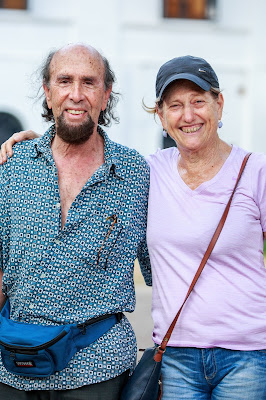As the Kochi Muziris
Biennale came to an end, on March 29, visitors, stakeholders, and
participants give their impressions
Photos: Pavneet Pal Singh; Rahul Nair and Meenakshi Soman, Isi and Zehavit Orlev and Jineesh, NA, the owner of the Al-Hala restaurant
By Shevlin Sebastian
His job is to take people
on guided tours. Every day, there are two public tours, lasting 90
minutes, at 11 a.m. and 3 p.m. The crowd is a mixed bunch of
foreigners and Indians. Apart from that, he gets assigned to
important guests like diplomats, politicians, film and cultural
celebrities.
Without realising it, there have been gains for Pavneet. “My public-speaking skills has
improved a lot, and I have learnt to deal with all types of people,” he says. But, mostly,
the visitors have reacted gratefully. “That is because contemporary art can be difficult to
understand so they need help,” says Pavneet.
Not surprisingly, Pavneet is keen to take part in the next edition but, as he says, “Preferably,
in some other role.” Finally, when asked about the art work which created the mostimpact on people, Pavneet says, “Raul Zurita's 'Sea of Pain'.” At that installation, youwalk across a foot-high sheet of water, inside a room at Aspinwall House. This is a poeticmetaphor about illegal migrants trying to cross over to Europe from Africa on rickety boatsthrough the Mediterranean Sea and losing their lives in the process.
Young and Creative
Walking swiftly through the grounds of Aspinwall House are Rahul Nair and Meenakshi
Soman, independent writers and documentary film-makers. For the Surat-based Rahul, this is
his second visit. “I had come earlier in December,” he says. “But when I heard that the
Biennale is ending on March 29, I decided to come again because I had not seen all the works.
And it has been great so far.”
So excited was Rahul that, after his first visit, he informed his friends, While a few took flights,several took the 32-hour train journey from Surat to come to the Biennale over the past three months.
For the Kochi-based Meenakshi, she has come often. “The best time is in the morning, justwhen it opens,” she says. “There are hardly any visitors and I enjoy walking around. Since theworks are so amazing, it has been a creative stimulant for me.”
Like, in the case of Rahul, Meenakshi's many friends from places like Pune and Mumbaimade he journey to see the Biennale. “They all liked it,” she says. “But they all agreed thatone day is not enough. You need to spend at least two to three days to see all the works.”
From Israel with love
at Allapuzha when they met Orna Lutski, a well-known Israeli artist.
“When she heard that we were going to stay at Fort Kochi for a
couple of days, she urged us not to miss the Biennale,” says Orna.
“That is why we are here.”
Both of them enjoyed the
Orijit Sen 'Going Playces' interactive art exhibition. “I saw a
few drawings that reminded me of the paintings of [Russian-French
artist] Marc Chagall,” says Isi. “We have liked what we have
seen. It is good that a major festival is taking place in Fort
Kochi, although both of us are finding it difficult to adjust to the
heat and the humidity.”
It is evening. And
Jineesh, NA, the owner of the Al-Hala restaurant, just near
Aspinwal House is sitting on the steps and having a chat with his
friends. Thanks to the location, he has done very good business
because of the Biennale. “Many visitors have come to my shop,”
he says. “The customers included both North Indians and
foreigners.”
The favourite order was
biriyani: chicken, prawn, fish and chicken. People also ordered
Chinese and fish dishes. “Our business grew by 35 per cent because
of the Biennale,” he says. “In fact, everybody has gained, like
the hotels, homestays, small shops and autorickshaw drivers. It has
been good for business. So I will feel a bit sad that the event ended on March 29.”
(The New
Indian Express, Kochi)




No comments:
Post a Comment